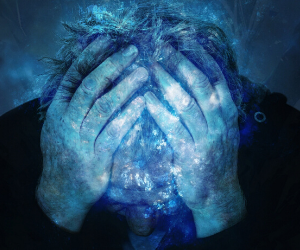A guest post by Dr. Joseph Cambray, President.

Our most recent Pacifica Experience Day was the first time we attempted to offer a recruitment event fully online, and I am happy to report that we had a rich, full engagement. I set aside most of my usual introductory remarks, as I thought it more important to try applying some relevant depth psychological reflections to the crisis of our emerging global novel coronavirus pandemic. I feel that it might be valuable to share them here.
Fear and anxiety abound, surrounding all of us, as this new highly infectious virus spreads rapidly. It is especially worrisome that it can endure on certain surfaces for extended periods. As it swamps our health care systems, the infection, both biological and emotional, is disrupting our regular, ordinary lives in ways unknown in the past; the closest equivalent that has been noted is wartime. Images of catastrophe, plague, and apocalypse arise under these conditions; uncertainty fuels our collective imaginations and empowers archetypal forces beyond human control.
As the carrier of these fearsome archetypal activations, the novel coronavirus can possess our minds and hearts, constricting our thinking through psychological rather than biological means. Thus, it may be useful to gain some other perspectives on the impact of the virus:
- From virology: viruses are generally thought of as molecular machines at the edge of biology and chemistry. Many of them can be purified and even crystalized (this was accomplished for the COVID-19 strain in late January 2020). In this state, viruses behave as if they were inanimate chemicals; the crystals can be stored for years without damage (i.e., suspended without energy input or discharge).
Existence between life and inanimate matter, a twilight realm partaking of both, is familiar to Jungians as the psychoid: this describes behaviors where substances display psyche-like qualities as well as having properties associated with materials lacking psychological responsiveness.
Synchronistic phenomena, where coincidences occur within the context of a meaningful, causal encounter, are envisioned as involving activations of psychoid archetypes. These phenomena are anomalous to most contemporary scientific cosmologies. Nevertheless, we may want to stay alert to synchronistic events emerging within the context of this crisis.
- Potential origins: the rise of a pathogen always occurs within an environmental context. Such pathogens or viruses are opportunistic and transgressive, emerging in response to changing conditions and having the potential to endanger all who come into contact with them. When we can step back from our panic about the dangers that they impose, although warranted to some degree, we may gain new insight into the way disturbed ecologies are implicated in the rise of particular pathogens. The current pandemic then becomes a kind of challenging teacher for modern societies.
- Environment: Without having the details of the evolutionary pathway, I suspect that the novel coronavirus reflects the climate traumas our world is undergoing. It has arisen within that context, jumping from animal/avian species to human, probably first in marketplaces in China. These markets often have exotic wild animals on display for sale. Their value is often linked to their rarity, making them curiosities and often the recipients of magical projections. They are sad representatives of the wildness of nature, not respected, but treated as food, amusement, with disgust/terror, but not valued for the diversity they offer. There seems to be some wish to ingest the imagined special powers they are thought to carry. Fortunately, China has now permanently banned all such markets.
- Blue Skies: On the contrary, when working with a group of Chinese psychotherapists recently, we discussed the impact of COVID-19. They are sensitive, ecologically aware individuals. In discussion, I relayed a story from the New York Times about the drop in coal usage in China—usual for the lunar New Year period as people return to their homes for holidays and much of the industrial sector closes. This year due to COVID-19, the decrease in coal use did not rebound, as many people were still in quarantine. The improvement in air quality was striking (equivalent to a full year’s worth of CO2 output of the state of New York!). One therapist immediately noted that these stated facts brought into relief an inexplicable sad feeling when standing outside a few days before where she observed the blueness of the sky. She realized her adaptedness to the absence of such blueness and felt a powerful twinge of nostalgia for a once less-polluted atmosphere—it was quite moving to witness.
- Isolation: As the US moves increasingly to “shelter-in-place,” life is slowing down; many are working from home, or not working but remaining at home. How will we use this isolation? Creativity is one very real possibility: a young Isaac Newton had to be in quarantined for over a year during the 1665-66 plague in London. During that time, he conceived many of his most important ideas, including a description of gravity—a truly remarkable achievement coming out of isolation.

Furthermore, the virus has made us acutely aware of our interconnectedness. In this age of nationalism and concern for borders, the virus has been transgressive, using our transportation systems to spread far and wide—no concrete walls keep it out. The challenge for us now is to work with our interconnectedness to enhance our interrelatedness, especially the caring and concern for those around us. The dangers and stresses of isolation can be profound. Penetrating the isolation, engaging (virtually in most cases) with one another, sharing stories, sharing lives and emotions will be essential to our communal well-being. We will need to connect via our imagination and emotion as well as through electronics. Perhaps, in a sheltered environment, the present slow-down can offer time and opportunity for reflection and innovation.
- Depression: Some of the consequences of isolation include depression, sadness, and a sense of loss (of contact as well as grief from deaths). We are also seeing this in the world economic markets: as they crash, recession may ensue and become more severe and sustained, so that economies, themselves, “fall” into depression. The economic and the emotional become coincident. Manic stimulation may provide a temporary boost, but deep solutions require a fuller reflective exploration on how we spiraled into this kind of drastic situation. Again, we have a challenge that may require a deep dive to confront the underworld forces of depression unleashed by the virus—will you be a part of the communal team undertaking this exploration?
- Taking a cue from the works of Colombian Nobel Prize winner Gabriel Garcia Marquez, particularly 100 Years of Solitude and Love in a Time of Cholera, we note that diverse words, for instance “Love” and “Cholera,” can share some curious traits. Perhaps depth psychology and viral life also have parallels in conceiving the psychoid, engaging with shadow materials for the sake of transformation, and how the illnesses we develop speak to something fundamental in our natures (the return of the repressed wild?). Is it time to listen to COVID-19?

Joseph Cambray is CEO-President at Pacifica. He is also past President of the International Association for Analytical Psychology; he has served as the U.S. Editor for the Journal of Analytical Psychology and is on the Editorial Boards of the Journal of Analytical Psychology, The Jung Journal: Culture and Psyche, and Israel Annual of Psychoanalytic Theory, Research and Practice. He has been a faculty member at Harvard Medical School in the Department of Psychiatry at Massachusetts General Hospital, Center for Psychoanalytic Studies; adjunct faculty at Pacifica Graduate Institute. Dr. Cambray is a Jungian analyst in Boston and Providence, RI. His numerous publications include the book based on his Fay Lectures: Synchronicity: Nature and Psyche in an Interconnected Universe and a volume edited with Linda Carter, Analytical Psychology: Contemporary Perspectives in Jungian Psychology. Some of his recent papers include: “Cosmos and Culture in the Play of Synchronicity,” Spring Journal, Jungian Odyssey Series, 4, 133-147, 2012; “Jung, science, and his legacy,” in International Journal of Jungian Studies, 3:2, 110-124, 2011; and “Moments of complexity and enigmatic action: a Jungian view of the therapeutic field,” in Journal of Analytical Psychology, 56 (2) 296-309, 2011.



